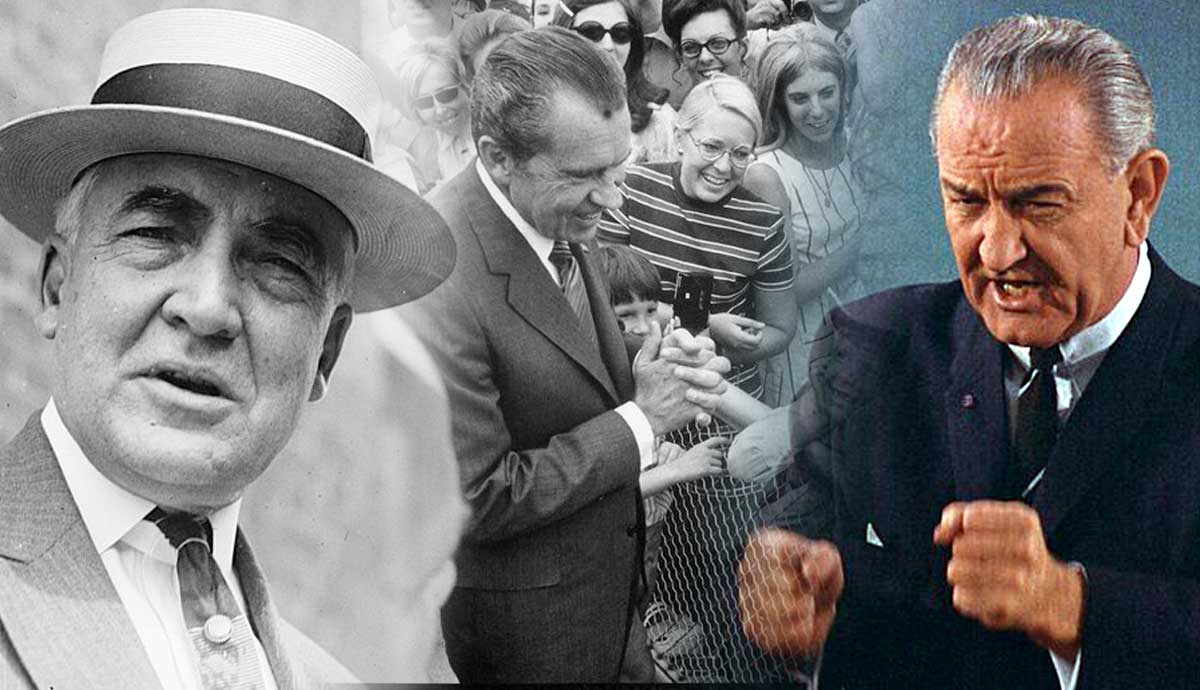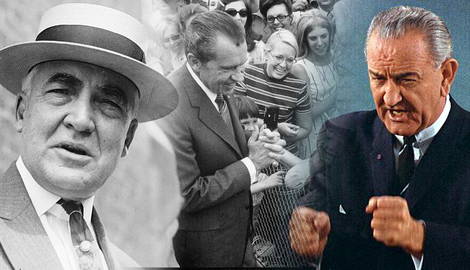
From Franklin D. Roosevelt’s dominance during the Great Depression to the more recent Ronald Reagan’s 1980 election, landslide elections underscore the American public desire for progressive change. While some pundits are quick to call an election a landslide, there have been, at most, only a few of what we could consider blowouts. It is more like a handful, especially when not counting George Washington, who was unanimously elected, and James Monroe, who ran unopposed.
1804: Thomas Jefferson

Although dating back to the 1800s when the United States was just getting used to operating under the Constitution and when popular elections were not yet commonplace, the landslide presidential victories of Thomas Jefferson and later James Monroe are significant for different reasons.
While not as historically important as his 1800 election, which saw the first peaceful transition of one political party to another in the White House in American history, Jefferson’s 1804 victory did much to validate the Democratic-Republican Party and, hence, the nation’s first-ever two-party system. The fledgling Federalist Party put forth Charles C. Pinckney, a former diplomat and military officer who was critical of Jefferson’s curtailed military spending and handling of foreign affairs, including the Louisiana Purchase, which doubled the size of the United States.
A staunch believer of small government and the idea of Federalism that saw the states co-govern with and not under the all-powerful federal government, Jefferson’s overwhelming victory in 1804 proved that the US’s “democratic experiment” worked. While precise popular vote totals from this period are not available due to varied methods of selecting electors in different states, Jefferson’s 162 electoral votes to Pickney’s 14 marked the beginning of the decline of the party of George Washington, the Federalists.
1820: James Monroe

The effect of Jefferson’s second victory could not be more evident less than two decades later in the election of 1820. The party was too weak to run an opposition candidate to the Democratic-Republican and Jefferson’s heir-apparent, James Monroe, during his own re-election bid. As the public applauded Monroe’s presidency for evoking political unity and fostering nationalism that followed the War of 1812, the Federalist Party, which opposed the conflict in the first place, was crumbling into oblivion. When the incumbent president’s supporters announced his candidacy for a second term—the Federalists did not follow suit—leading to an unopposed election, the first since George Washington, and since, last.
With the election a foregone conclusion and with the president not having an opponent to run against, Monroe won 231 out of 232 electoral votes, with only one elector, William Plumer of New Hampshire, voting against him to ensure that George Washington remained the only president to be elected unanimously. Plumer voted for John Quincy Adams. The relative party unity that aligned itself behind Monroe, while rare in American history, would not last as the Democratic-Republican Party would itself soon split into competing factions.
1920: Warren G. Harding

One of the more forgotten landslide victories of the 20th century occurred in the 1920 election directly following the end of World War I. The nation was weary and disillusioned by the great conflict and craved a return to pre-war life. In one of the best public relations coups, Republican Warren G. Harding’s campaign managers adopted the slogan “Return to Normalcy.” After years of making do with rationing and the government’s economic and social censorship, American voters were attracted to the Ohio senator’s personality, charisma, and geniality. He resonated with the new national sentiment, ready to get past the gloom of the war years.
Yet, what likely led to Harding’s overwhelming victory in November had nothing to do with him and everything with the Democratic Party at the time. The party mirrored the anxiety of many Americans who disliked the outgoing President Woodrow Wilson’s proposal to join the new League of Nations, which they saw as entangling the US in foreign conflicts. The Democratic Party, split between those in support and those opposing Wilson, chose a neutral, and by all standards, unknown safety nominee, James M. Cox of Ohio, to represent them in November.
With post-war strikes and labor unrest fueling further anxieties about the social order, Harding presented himself not only as an opponent to further international entanglements through the League of Nations but also as a moderate who could restore the much-needed stability. The Ohio senator beat his statemate with 404 electoral votes to 127, collecting 60.4% of the popular vote. Cox was so insignificant in the election that Harding’s campaign largely ignored him and campaigned against the outgoing President Woodrow Wilson’s record.
1932 and 1936: Franklin D. Roosevelt

By the 1932 election, the Great Depression had already ravaged the US economy, leading to massive unemployment, bank failures, and widespread poverty. President Hoover’s belief in “rugged individualism,” emphasizing self-reliance and minimal government intervention in the economy, led many Americans to believe that their government had abandoned them. Hoover did more than any prior president to expand the federal government’s role in steering the national economy through his Emergency Relief and Construction Act of 1931. Yet, it was deemed too little and too late.
New York Governor Franklin D. Roosevelt ran on a platform promising a “New Deal” for the American people. The Americans blamed Hoover for the economic hardships and perceived inability to address the crisis effectively, making this a runaway election for the rising Democrat. Where Hoover’s campaign was defensive, FDR’s was dynamic and optimistic, offering hope and new policies to tackle the worst of the Depression. While not as comprehensive as his re-election four years later, FDR’s landslide victory in 1932 saw him clinch 472 electoral votes to Hoover’s 59, carrying 42 out of the 48 states with 57.4% of the popular vote.
When 1936 came around, Roosevelt’s New Deal programs had been providing relief to many Americans for years and slowly seeing the nation on the path to recovery. FDR’s administration created an enormous bureaucracy that some saw as threatening individual liberty and free markets, yet he continued championing and promising further efforts to support the struggling Americans. Since FDR’s opponent, Republican Governor of Kansas Alf Landon, did not present a compelling alternative, he received only 36.5% of the popular vote in November to Roosevelt’s 60.8%. FDR won his re-election with 524 electoral votes to Landon’s eight, carrying 46 states. The New Deal had won, and the Democratic Party was now the party of working-class Americans.
1964: Lyndon B. Johnson

Having assumed the presidency after the assassination of John F. Kennedy in November 1963, President Lyndon B. Johnson (LBJ) sought a victory in 1964. The Democrat’s record highlighted decades in public service, with twenty-six years of congressional experience and a reputation as a man who got things done.
Bent on leaving a lasting legacy as president, Johnson declared an “unconditional War on Poverty in America.” LBJ spent 1963 and 1964 pushing through Congress initiatives that would, in his first full term, fall under a more comprehensive Great Society program, like the Economic Opportunity Act and Job Corps, to empower underprivileged people through education, job training, and community action initiatives.
By 1964, Fortune magazine summarized the national feeling about the president: “Lyndon Johnson has achieved a breadth of public approval few observers would have believed possible when he took office.” Johnson ran his election campaign on a platform of continuing his predecessor’s legacy, promoting civil rights, and advancing his broad visions of a “Great Society” that aimed to eliminate poverty and racial justice.
His Republican opponent, Arizona Senator Barry Goldwater, had a staunch conservative agenda that was significantly different. Goldwater advocated for a more aggressive stance against the Soviet Union, less government intervention in the economy, and opposition to the Civil Rights Act of 1964, signed into law by Johnson on July 2, 1964, arguing that the latter infringed on states’ rights.
Ultimately, the Arizona senator’s positions on social issues and foreign policy proved too extreme for American voters. On Election Day, President Johnson won 486 electoral votes, carrying 44 states to Goldwater’s 52 electoral votes. LBJ secured 61.1% of the popular vote to his opponent’s 38.5%, with the latter carrying only his home state of Arizona and five states in the Deep South.
1972: Richard Nixon

Although often overshadowed by the Watergate scandal and Richard Nixon’s subsequent resignation, the election of 1972, which acted as an impetus for the bugging of the Democratic headquarters in the infamous Washington DC hotel, is one of the most significant landslide victories in presidential elections.
Nixon’s bid for a second term came on the heels of significant successes such as the withdrawal of US troops from Vietnam, the nation’s most contentious conflict in history, the successful Apollo moon landings, and détente with the Soviet Union and China. On the other hand, the president’s challenger, George McGovern, a Democratic senator from South Dakota, was known for his strong opposition to the Vietnam War and his advocacy of liberal policies, one of the more controversial being his proposal to provide every American with a guaranteed minimum income.
With the Watergate scandal looming on the horizon—although the break-in at the Democratic Headquarters was not yet tied to the incumbent president—Richard Nixon easily won his re-election bid. The thirty-seventh Commander-in-Chief received 520 electoral votes, carried 49 states, and secured 60.7% of the popular vote compared to his opponent’s 37.5%, granting him one of the largest margins of victory in United States history.
1980 and 1984: Ronald Reagan

While some elections in American history have been too close to call, even extending past their November dates to calculate, the same cannot be said about the landslide victories of the Republican Party’s arguably most famous president, Ronald Reagan. When he first ran for the executive office in 1980 against the incumbent President Jimmy Carter, the California governor appealed to those frustrated with the economy and America’s weakening global position. Reagan promised to lower taxes and increase military spending while also winning the conservative vote by seeking a constitutional amendment banning abortion.
“Are you better off than you were four years ago?” Reagan asked the American people during one of his debates against Carter. With high inflation, a national fuel shortage, and the perceived inability of the president to free American hostages in Iran, public opinion polls had the incumbent president’s popularity lower than Richard Nixon’s during the Watergate scandal. The public responded to Reagan’s question with a resounding “No,” giving him 51% of the popular vote and 489 electoral votes to Carter’s 49. It was the first time since 1954 that a Republican called the White House home.
President Reagan repeated the landslide feat four years later. Although he was at the time the nation’s oldest candidate for president at 73 years old, Reagan’s record of a strong economy and revival of national confidence and power worldwide saw the president claim an overwhelming victory in November 1984. Reagan won 58.8% of the popular vote and carried 525 electoral votes to his opponent Walter Mondale’s 13. The Republican candidate also won 49 out of the 50 states, losing only Mondale’s home state of Minnesota. When the dust settled, it was the second-largest share of the electoral college for a candidate since 1820—a record for the Republican Party.










